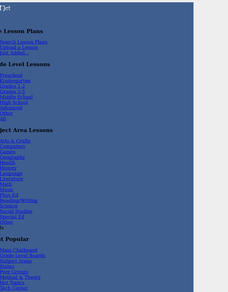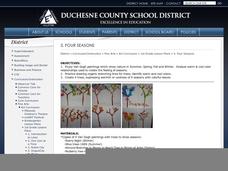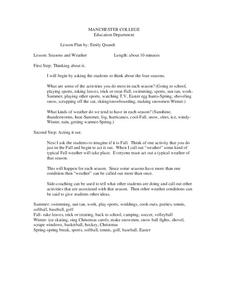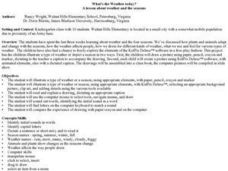Curated OER
Four Seasons - Internet Research
Students review the four seasons and discuss what type of clothing they should wear in each season. They use the Internet to explore the weather during the different seasons.
Curated OER
Outdoor Observation
Second graders explore Earth science by participating in a nature observation activity. For this four seasons lesson, 2nd graders identify the four seasons on Earth and the weather patterns they are known for. Students read several books...
Curated OER
Why Do We Have Seasons?
First graders watch a video about the seasons. They role play with the teacher the sun and earth. The student's heads are the earth, their foreheads are the Northern Hemisphere. The teacher shines a flashlight on them to simulate the sun...
Crayola
Autumn Scratchings
Students discuss some of the signs of changing seasons. They are asked how do they know that it is fall? Students use Crayola Crayons, to rub patches of traditional fall colors on white construction paper. They fill the entire sheet with...
North Carolina Museum of Natural Sciences
Weather Watch Activity Guide: Groundhog Day
Exactly what do groundhogs know about weather? Not as much as your science students will after completing these lessons and activities that cover everything from the earth's rotation and the creation of shadows, to cloud...
Curated OER
Weather and Seasons
Learners identify weather terms associated with the four seasons and participate in a game "What is the Weather" using weather vocabulary to describe a season.
California Academy of Science
Kinesthetic Astronomy: Longer Days, Shorter Nights
A lamp, four globes, and some signs taped around the room are all you need to set up a solar system simulation for teaching how Earth's tilted axis creates the seasons. (Sticky dots are also needed, but not mentioned in the materials...
Core Knowledge Foundation
Cycles in Nature Tell It Again!™ Read-Aloud Anthology
A read-aloud anthology offers stories all about nature's life cycles. Over three weeks, second graders listen to and discuss tales about the cycles of daytime, nighttime, seasons, plants, trees, frogs, butterflies, and water. Following...
Alabama Learning Exchange
Seasons
Learners explore the four seasons through literature, art activities and technology and explore how the earth's rotation around the sun results in the occurrence of the four seasons.
Curated OER
The Four Seasons
Students examine four paintings by Robert Harris and identify the season portrayed. Using the characteristics for each season, they write a poem and create a drawing of their own. In groups, they describe the different types of...
Curated OER
Four Seasons
First graders examine and describe the characteristics of the four seasons. Using a computer, they write one sentence about each of the four seasons and draws an illustration to accompany it. They present each drawing and sentence to the...
Alabama Learning Exchange
The Four Seasons
Students who are special needs and early elementary students study facts about the four seasons. They listen to read aloud books about each season before completing associated graphic organizers. They illustrate pocket books to hold all...
Chicago Botanic Garden
Seasons of a Plant
Reading the cues from nature can be as much an art as a science. The second installment in a six-part unit on climate teaches learners that environmental and biological events have significance. They first learn the difference between...
Curated OER
Seasons and Cloud Cover, Are They Related?
Students use NASA satellite data to see cloud cover over Africa. In this seasons lesson students access data and import it into Excel.
Curated OER
Earth's Tilt Creates Seasons
Learners examine how the Earth's tilt creates the seasons. In this seasons lesson plan, students study a diagram that shows the rotation of the earth around the sun and how it tilts during the rotation. They answer 4 discussion questions...
Curated OER
Journey North 1999
This is not a lesson plan, but an outstanding resource to provide material for your lessons on seasonal changes and animal migration. Links connect you to live web cams and up-to-date information on Monarch Butterflies, hummingbirds,...
Curated OER
Seasons and Weather
Students, in an open forum with the teacher, discuss the four seasons and all the activities they do during each season. They tie in all the different types of weather that is experienced during each season. In conclusion, the students...
Curated OER
The Colors of Seasons
Students observe each season and and mark the colors they see. In this colors of the seasons lessons, students read The Mystery of the Missing Hummingbirds and compare their results and note variations of colors in the different...
Curated OER
Subsistence Calendar
Students create a subsistence calendar for seasonal activities in their community. In this seasonal activities lesson plan, students research the four seasons in their community and write down the activities to do in that season.
Curated OER
Weather And The Seasons
Students illustrate characteristics of the different seasons using digital and pen and paper drawings. They creat captions for their drawings and present them to the class. Students compare and contrast their pen and paper drawing...
Curated OER
Seasons
First graders create a KWL chart about the four seasons. In this four seasons lesson plan, 1st graders continue the chart by watching videos and drawings.
Curated OER
The Four Seasons: Spring, Summer, Fall, Winter
Learners discuss the seasons and what the weather is like during each. In this seasons and weather lesson, students discuss what activities take place during each season. Next, learners learn the song What Shall We Do and write new...
Curated OER
The Four Seasons - Earth's Axis
Young scholars discover that it is the tilt of the earth's axis that results in the seasons. They clarify common misconceptions about the earth's orbit around the sun.
Alabama Learning Exchange
The Sun and the Earth
Third graders study and diagram the positions of the Earth and sun during the four seasons. They predict weather for cities in the northern and southern hemispheres.
























